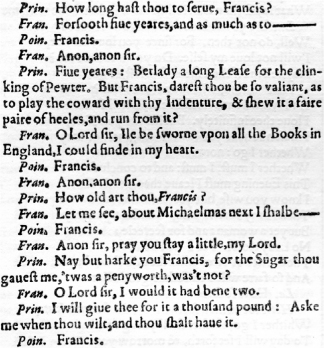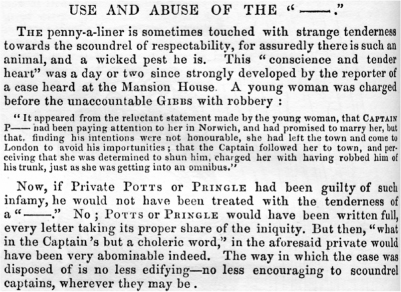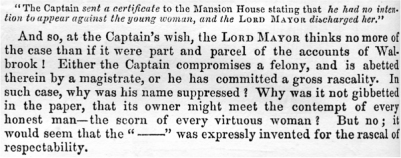Making a Point (16 page)
Authors: David Crystal

Why did I write it in this way? Because I don't know whether my reader will be familiar with the technical use of
correlative
. If I don't gloss it, I may leave some readers in the dark:
When the inclusion is medial and short, it takes its place alongside other
correlative
uses of punctuation.
But if I build it into the sentence, readers who are familiar with the term might think I'm talking down to them:
When the inclusion is medial and short, it takes its place alongside other
correlative
uses of punctuation, which are marks that have to be used twice.
I can imagine a reader thinking with irritation: âI know what
correlative
means, Crystal, you don't have to tell me!' The dash allows me to express a âtake it or leave it' effect. If you know what
correlative
means, ignore what follows. If you don't, pay attention to it.
Edgar Allan Poe made a similar point. In a Marginalia column for
Graham's Magazine
(February 1848), he made a vigorous defence of the dash, inveighing against the way printers replaced dashes by a semicolon or comma â a reaction, he felt, to the excessive use of the dash by writers a few decades before. The dash, he said (defining and illustrating at the same time), ârepresents a
second thought â an emendation
'. And he goes on:
The dash gives the reader a choice between two, or among three or more expressions, one of which may be more forcible than another, but all of which help out the idea. It stands, in general, for these words â âor,
to make my meaning more distinct
.' This force
it has
â and this force no other point can have; since all other points have well-understood uses quite different from this. Therefore, the dash
cannot
be dispensed with.
Finally, we should note the use of the em dash to show that there's been an interruption in a dialogue. This convention is very old. We see it in Shakespeare's First Folio, when Hal and Poins persistently interrupt the tavern-waiter Francis (
Henry IV Part 1
, 2.4.40):

There's no standard width. The typesetter simply extends the dash to fill the rest of the line.
So, in the light of these various uses of the em dash, why
would someone end a sentence with a dash, as in
It's time you went home â
? This isn't an interruption. The speaker has decided to come to a sudden stop. Why would speakers do this? It's a favourite novelist's device, when characters suddenly realize that they are unwilling or unable to carry on. Perhaps they have said too much, or are too upset to continue. There are several possible interpretations, which a novelist often glosses:
âIt's time you went home â'
Martha stopped abruptly, remembering that the police were watching the house.
The effect has a long history. Classical rhetoricians called it
aposiopesis
, from a Greek verb meaning âto keep silent'.
An interlude about the Dâ
During the eighteenth century, a long dash came to be used as a mark of supposed anonymity in newspapers, novels, letters, cartoon captions, and some public announcements. It was used for places and people where the writer wished to avoid writing a name out in full. In a novel, it might be because the actual location or person is unimportant. In a letter, the identity would be known to the reader, so the writer would be sharing some sort of joke or perhaps hinting at a sensitive issue â as when Jane Austen writes to Cassandra (8 January 1799) about âWâWâ's Mama' (probably a reference to a neighbour). In newspapers, it was used as a tabloid trick to avoid a legal comeback, enabling someone to be mentioned without actually saying who they were.
Punch
, the arch-enemy of hypocrisy in the nineteenth century, was quick to attack the practice. In issue No. 23 in 1845, we see a reporter (a âpenny-a-liner' â a journalist paid by the line) apparently having an attack of conscience at the way a magistrate (a Mr Gibbs) dealt with a case:


Punch repeatedly satirized the practice. In an âImaginary Conversation' published in No. 27 (1854), the dialogue is introduced by a list of the anonymous characters:

Readers of the time would have needed no gloss. For modern readers: Princess Louisa Caroline Alberta (sixth child of Queen Victoria), the Earl of Aberdeen (First Lord of the Treasury), Lord John Russell (President of the Council).
18
Ellipsis dots or â¦
It's time you went home â¦
An unspaced sequence of three periods is usually called an
ellipsis
â more fully,
ellipsis dots
or
suspension dots
.
Ellipsis
means that something has been left out. In grammar, it refers to the omission of part of a preceding sentence, as in the sequence
Where are you going? Home
. (=
I am going home
.) In punctuation, along with the dash, it's the main way of expressing semantic incompleteness.
We see it in traditional formal writing when a piece of information is deliberately omitted, as when we choose to exclude part of a quotation:
The important point ⦠is that the article will be published.
Here the omitted words might be âI must emphasize'. There's no rule governing the amount of text that is covered by ellipsis dots, but it would be unusual for the separated units not to be close to each other in the original text.
A related use shows that a quotation could have continued, but has been arbitrarily ended, as in my examples from
The Memors
in
Chapter 14
:
Bob Holpweed tucked the local newspaper under his arm and went to the park. â¦
And we also see it expressing continuation when we wish
to convey the notion of âsomething that it is unnecessary to specify further':
Imagine a sequence of numbers: 5, 10, 15, 20 â¦
To be or not to be â¦
When in Rome, you know â¦
There are several examples of ellipses at the ends of sentences or quotations in the present book. See, for example, its use in the title to
Chapter 1
, taken up as
continuation dots
in the title to
Chapter 2
. Or the various quotations in
Chapter 12
.
This use of ellipses can be manipulative, and isn't always ethical. Imagine a play review in the
Daily Blah
that begins like this:
The production is less the brilliant, perceptive interpretation and electrifying performance claimed in its publicity, than a bathetic pandering to the London audience's most basic instincts.
Then later, you read:
Brilliant, perceptive ⦠electrifying. (
Daily Blah
)
With any form of advertising, it always pays to check what's been omitted.
A third type of ellipsis can be illustrated by the way I used it at the very beginning of
Chapter 14
:
a continuous piece of writing, or
text
â whether it be a book, a chapter, an essay, a newspaper report, a letter, a signpost, an email, a blog â¦
This is a further example of âsomething that it is unnecessary to specify further', but here the meaning is vaguer. I am assuming the reader will be able to add to this list, but there
is no guarantee that each reader will add to the list in the same way. Writers have to be careful when using ellipsis like this. They need to ensure that the reader will be able to see the semantic connection between the items in the list. If the unifying factor isn't immediately obvious, the writer needs to make it clear in the context, to avoid a charge of lazy writing.
Ellipsis dots have not always had a good press, for this reason, and some stylists recommend avoiding them. But this is going too far. When used carefully, the vagueness they convey can be dramatically valuable. In dialogue it can mark a silence, with all that this entails â uncertainty, threat, embarrassment, melancholy, something unspoken ⦠Harold Pinter was the literary master of this kind of rhetorical ambiguity. In
The Caretaker
, the aggressive Mick tells the homeless arrival Davies about his brother Aston:
MICK. He's supposed to be doing a little job for me ⦠I keep him here to do a little job ⦠but I don't know ⦠I'm coming to the conclusion he's a slow worker.
Pause
.What would your advice be?
DAVIES. Well ⦠he's a funny bloke, your brother.
MICK. What?
It's up to the director and actors to interpret these ellipses, and there are several possibilities, most of them uncomfortable. Menace is never far away during a Pinteresque pause. Silences are ominous, not golden.
Ellipses dominate the graphic character of
The Caretaker
. I've never seen anything to match the elliptical nature of its final lines:
ASTON: You make too much noise.
DAVIES: But ⦠but ⦠look ⦠listen ⦠listen here ⦠I mean â¦
ASTON turns back to the window
.What am I going to do?
Pause
.What shall I do?
Pause
.Where am I going to go?
Pause
.If you want me to go ⦠I'll go. You just say the word.
Pause
.I'll tell you what though ⦠them shoes ⦠them shoes you give me ⦠they're working out all right ⦠they're all right.
Maybe I could ⦠get down â¦
ASTON remains still, his back to him, at the window
.Listen ⦠if I ⦠got down ⦠if I was to ⦠get my papers ⦠would you ⦠would you let ⦠would you ⦠if I got down ⦠and got my â¦
Long silence
.Curtain
.
This kind of writing works because it's possible for us to relate the speech patterns to our everyday experience of pausing and tone of voice. We do often speak in this way. For example, if we were to write down the following spoken exchange, ellipsis dots provide the most appropriate means of conveying the unspoken part of the message:
A: Where's the er â¦
B: First on the right upstairs.
Any spoken evasion of a tricky or awkward subject can be represented in writing in the same way:
A: I think you should ⦠you know â¦
B: Tell him, you mean?
No other punctuation mark conveys tentativeness like this, suggesting a voice trailing off into an uncertain silence.
Certain types of novel and short story also rely on ellipsis dots at critical points in the narrative. Detective stories depend on them when the characters withhold information, either deliberately or because they die before they can reveal what happened:
âWho did it? Who did it?'
âIt was ⦠it was â¦'
Here the incompleteness is a critical plot device, for if the victim had been able to finish his sentence, the story would have been over. Any interrogation scene is likely to use ellipsis dots, with interrogators posing leading and unfinished questions and interrogatees responding â either deliberately or through exhaustion â with evasive and partial answers. Investigators who are puzzled rely on them too:
Was the weapon here, somewhere, in this house? Was that why Joe Burch was uneasy and conciliatory?
Poirot did not know. He did not really think so. But he was not absolutely sure â¦
This is the end of the chapter. The ellipsis as cliffhanger â a favourite device of Agatha Christie (
Chapter 5
of
Mrs. McGinty's Dead
, 1952).
Ellipsis dots have gained a new lease of life in electronic communication, where they perform a variety of functions. This isn't the place to go into the various technical uses they have in programming languages, but everyone who works or plays online will have had to understand the following uses of ellipses:
- A request for further information, following a command.
An example is the contrast between
Save
and
Save Asâ¦
In the first case, a page will be saved without any further action on the part of the user. In the second, the user needs to provide a filename. - An indication that there are options available:
Preferences⦠Zoom⦠- A report on the status of an operation:
Updating⦠Downloading⦠- In contexts such as chatrooms or instant messaging, a signal to a recipient that the sender is about to send a further message:
Dave says: I think I have that infoâ¦
Dave says: It's on Friday
- An indication that a link does not fit in the space available â something that happens often in short-message formats such as Twitter. In this example, the full address of the link has been automatically abbreviated to respect the limit of 140 characters:
A comment on the latest horror story to come out of the KS2 grammar tests in the UK:
http://david-crystal.blogspot.co.uk/2013/09/on-notâ¦
Visually, the graphic form of ellipsis dots seems very straightforward, but there are some subtleties of usage, both in manuscript and in print. If we decide to use them in handwriting, such as in an informal letter, they are often erratically written, with different amounts of space on either side, and with varying spaces between the dots. The number of dots may also vary, in what is called
extended ellipsis
. Writers add as many dots as they want, reflecting a personal style or just a playful whim. We also sometimes see varying numbers of dots in print, such as in comic strips, especially when
characters continue a conversation across the panels. And varying numbers of dots are common these days on screen. In informal Internet exchanges, we may see long sequences, as multiple repetition is a simple matter of holding down the period key.
So â¦â¦â¦â¦. are you going to come over?
Doubtless some of these sequences have a semantic purpose, reflecting the length of the intonation pattern the writer has in mind, or conveying degrees of attitude or implication. Just as likely, the number of dots in a string has no semantic point, merely reflecting an idiosyncrasy on the part of the sender.
Although printers have the option of varying the width of spaces when typesetting a page, there is no such option available to the general user. Whether using an old-style typewriter or the latest keyboard, pressing the space-bar introduces a space of fixed width. Thus the only matter that is under the control of the writer is whether to introduce a space or not, either within the ellipsis itself (⦠vs â¦) or at its boundaries, where there are four possible options:
(a) The important point ⦠is that nobody is excluded.
(b) The important pointâ¦is that nobody is excluded.
(c) The important point⦠is that nobody is excluded.
(d) The important point â¦is that nobody is excluded.
Most publishers go for (a), using a specific ellipsis character that keeps the dots together and includes a moderate degree of space between them, and this is available if you are desktop publishing. The unspaced version, (b), though formerly common, is now generally avoided on the grounds that it results in a dense-looking text, with decreased legibility â but it will nonetheless still be encountered.
Are there any grounds for asymmetrical spacing, as in (c)
and (d)? In the above examples, where the ellipsis simply means âmaterial omitted', it would be considered bad practice. But in certain circumstances the exact location of the ellipsis can have a linguistically contrastive force. Imagine you want to omit a piece of the following discourse.
Is there any shred of evidence that Smith travelled by train to London with Jane Williams? Is there any evidence that Brown travelled to Manchester? Is there any evidence that Jones travelled to Glasgow?
You have three options, each of which is signalled by a different placement of the dots:
- Option 1: something has been removed from between the two sentences
Is there any shred of evidence that Smith travelled by train to London with Jane Williams? ⦠Is there any evidence that Jones travelled to Glasgow?
- Option 2: something has been removed at the end of the first sentence, but nothing has been removed at the beginning of the second
Is there any shred of evidence that Smith travelled by train to London� Is there any evidence that Brown travelled to Manchester?
- Option 3: something has been removed from the beginning of the second sentence, but nothing has been removed from the end of the first
Is there any shred of evidence that Smith travelled by train to London with Jane Williams? â¦that Brown travelled to Manchester? â¦that Jones travelled to Glasgow?
In Options 2 and 3, as shown here, the ellipsis is often placed solid against the adjacent text, reinforcing its role as part of its mother sentence. Solid setting is the norm in Internet commands, such as
Save Asâ¦
These are illustrations of the way the linguistic system operates, not rules of usage. Practice varies enormously among individuals and among the style manuals, and defies easy summary. In the days of heavy punctuation, we would even see ellipses within square brackets, reinforcing the point that the dots are added by the author and are not part of the original text:
The important point [â¦] is that nobody is excluded.
And one usage issue in particular is worth noting: practice is divided over whether there should be a fourth period if the ellipsis occurs at the end of a statement and there is another sentence following. Compare:
Imagine a sequence of numbers: 5, 10, 15, 20 â¦
Imagine a sequence of numbers: 5, 10, 15, 20 â¦.
The four-point option is much more common in American English than in British English printing. A fourth dot may seem unnecessary, but it can be justified if we think of it indicating a semantic contrast with other marks:
Imagine a sequence of numbers: 5, 10, 15, 20 â¦.
Imagine a sequence of numbers: 5, 10, 15, 20 �
In most cases, though, the typographical variations relating to the presentation of ellipsis dots have little or no semantic content. The choices are made solely on aesthetic, house-style, or other pragmatic grounds.
